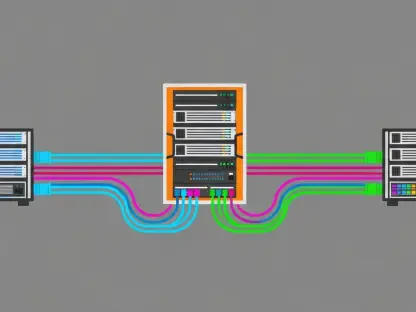The photonics industry is experiencing rapid growth driven by market demands, technological advancements, and geopolitical influences. Companies in this space must innovate quickly and economically, focusing on high-performance products. To stay competitive, executives can leverage open-source hardware and software for measurement and control systems.
The Importance of Precise Measurement and Control in Photonics
Critical Devices for Photonics Companies
Precise measurement and control devices are indispensable for photonics companies aiming to harness the full potential of optical components like lenses, mirrors, and lasers. These devices include DAQ cards, oscilloscopes, spectrum analyzers, and fast feedback controllers. Accurate measurements are the cornerstone of developing high-performance photonics products, ensuring that they meet stringent industry standards and satisfy customer expectations. Without these critical measurement tools, achieving the desired precision and quality in photonics innovation would be incredibly challenging.
Measurement technology’s significance in photonics cannot be overstated. It directly impacts the efficacy of complex optical systems, driving advances in various applications, from telecommunications and medical devices to industrial manufacturing and scientific research. As market demands for more efficient and powerful photonics solutions grow, the need for precise control and measurement devices becomes increasingly essential. Staying ahead of the competition in this rapidly evolving industry necessitates continuous innovation, underpinned by these advanced technologies.
Challenges with In-House and Ready-Made Solutions
A prevalent misconception within the photonics industry is that building in-house measurement devices is prohibitively expensive. Although it is feasible to create these devices affordably, the perception that it requires significant financial investment persists. Consequently, many photonics companies opt for ready-made solutions from well-established providers like Zurich Instruments and Liquid Instruments, renowned for their reliability. However, these pre-packaged solutions often come with their own set of drawbacks, including escalating production costs, integration challenges, and limitations in flexibility.
Ready-made measurement solutions, while reliable, can be bulky, expensive, and not always tailored to the specific needs of a burgeoning photonics company. The inflexibility associated with these devices can stifle innovation, as they may not be adaptable enough to keep pace with the rapid developments in the industry. Moreover, the high costs associated with integrating proprietary systems or licensing patents can add to the financial burden, making it harder for companies to maintain a competitive edge. These challenges underscore the need for more efficient and adaptable measurement solutions that can better support the photonics industry’s dynamic nature.
Advantages of Custom Measurement Systems
Benefits of Building In-House
Building custom measurement systems in-house presents several significant advantages for photonics companies. By designing custom electronics tailored to specific requirements, firms can achieve optimal performance, size, and cost efficiency. This level of customization enables companies to develop measurement solutions that precisely meet their operational needs, enhancing overall system performance and reliability. However, this approach does necessitate a substantial investment, particularly in hiring specialized RF engineering experts and securing the necessary development resources.
An in-house custom solution allows for greater control over the design and functionality of measurement systems, which can lead to superior outcomes compared to off-the-shelf alternatives. Custom-built devices can be adapted and modified as technological advancements occur, ensuring that companies remain at the forefront of innovation. This adaptability is crucial in an industry characterized by rapid change and evolving market demands. By investing in custom measurement systems, photonics companies can better position themselves to respond to new opportunities and challenges, ultimately driving long-term growth and success.
Prototyping with Development Boards
Prototyping with development boards like FPGA boards and FMC ADC/DAC modules offers an efficient and cost-effective approach for photonics companies seeking to create custom measurement systems. These boards provide a flexible platform for initially testing and refining measurement devices before committing to full-scale production. This prototyping phase is invaluable, allowing companies to experiment with various configurations and functionalities to determine the most effective solutions without significant upfront investment.
Despite their advantages, scaling prototypes made with development boards to a production level can be challenging and complex. The transition from prototype to final product often involves navigating cost barriers and technical hurdles, which can be daunting for many organizations. However, the iterative process of prototyping allows for continuous improvement and optimization, ultimately leading to more robust and effective measurement systems. By leveraging development boards, photonics companies can balance innovation with practicality, ensuring that their custom solutions are both attainable and scalable.
Leveraging Open-Source Hardware and Software
Introduction to Single-Board Computers
Photonics companies often face a dilemma when choosing measurement solutions: They must decide whether to rely on bulkier, inflexible ready-made solutions, invest heavily in custom electronics, or prototype with development boards that may not scale efficiently. A promising alternative is leveraging open-source hardware and software, particularly with single-board computers (SBCs). Exemplary SBCs from companies like Red Pitaya and Raspberry Pi are compact, powerful circuit boards equipped with microprocessors, memory, input/output components, and connectivity options. These devices offer a versatile platform for developing precise measurement systems tailored to specific photonics applications.
Single-board computers, equipped with open-source drivers and specialized FPGA processors, excel in facilitating analog-to-digital and digital-to-analog conversion, which are critical for photonics measurements. This hardware is particularly advantageous because it allows for rapid development and integration, ensuring that companies can quickly adapt to new technological advancements. Furthermore, SBCs are designed to be compatible with existing programming environments such as C, LabVIEW, MATLAB, Python, or Scilab, which streamlines their incorporation into current workflows, reducing downtime and increasing productivity.
Compatibility and Integration
Ensuring that single-board computers used in photonics measurement systems are compatible with existing programs such as C, LabVIEW, MATLAB, Python, or Scilab is crucial for seamless integration into existing workflows. Such compatibility minimizes disruptions and maximizes efficiency, allowing photonics companies to leverage their existing software tools and expertise. Open-source SBCs are designed to facilitate this integration, providing support through open-source drivers and a variety of connectivity options that cater to different technical requirements.
The integration of SBCs into photonics applications is further supported by a wealth of community resources, including forums, documentation, tutorials, and prebuilt components. These resources empower companies to develop truly customized measurement systems that meet their specific needs without being constrained by proprietary program lock-ins. This level of adaptability not only enhances operational efficiency but also fosters innovation by enabling companies to freely experiment with different configurations and solutions, ultimately leading to more advanced and effective photonics products.
Advantages of Open-Source Technology
Development and Integration Ease
Open-source single-board computers provide numerous advantages to photonics companies by offering an easy development and integration process. They run on open-source software, which not only facilitates rapid bug resolution but also encourages feature development through robust community feedback. This collaborative environment allows companies to quickly identify and address any issues, ensuring that their measurement systems remain efficient and reliable. Additionally, the availability of extensive online resources, including forums, documentation, tutorials, and prebuilt components, supports in-house development, enabling companies to create customized measurement systems that precisely meet their needs.
The open-source approach contrasts sharply with the constraints imposed by ready-made devices, which often require companies to conform to predetermined programs and functionalities. By using open-source SBCs, photonics companies can maintain greater control over their measurement systems, allowing for more flexibility and innovation in their product development processes. This adaptability is crucial in an industry characterized by rapid technological advancements and evolving market demands. By embracing open-source technology, companies can ensure that their measurement solutions are always aligned with the latest industry trends and standards.
Cost-Effectiveness and Sustainability
Open-source single-board computers offer photonics companies cost-effective and sustainable solutions for their measurement system needs. These boards are typically produced in large quantities and regularly updated, ensuring that they are both affordable and readily available. This mass production also helps mitigate supply chain disruptions, which can be a significant concern in the fast-paced photonics industry. Furthermore, the multifunctional nature of these boards allows them to be updated and reused instead of discarded, aligning with sustainability goals and reducing electronic waste.
In addition to their cost-effectiveness and sustainability, open-source SBCs support long-term innovation and growth by providing a flexible platform for continuous improvement. Companies can easily modify and update their measurement systems as new technologies emerge or as their specific needs evolve. This adaptability is crucial in maintaining a competitive edge in the ever-changing photonics landscape. By leveraging open-source technology, photonics companies can not only enhance their operational efficiency and reduce costs but also contribute to a more sustainable and environmentally friendly industry.
Addressing Industry Challenges
Balancing Cost, Precision, and Flexibility
The photonics industry faces core challenges in balancing cost, precision, and flexibility in measurement and control systems. Open-source technology offers a competitive edge by streamlining development cycles, cutting costs, and reducing dependency on external providers. By adopting open-source solutions, companies can achieve scalable, cost-effective, and flexible development. This strategic advantage positions them for long-term success, enabling them to navigate the complexities of the photonics market and remain at the forefront of technological advancements.
Open-source solutions provide the versatility required to balance these competing demands effectively. Companies can tailor their measurement systems to specific applications, ensuring that they achieve the necessary precision without incurring prohibitive costs. The ability to modify and adapt these systems as needed allows for greater innovation and responsiveness to market changes. This flexibility is essential for addressing the diverse challenges of the photonics industry, from maintaining high standards of accuracy to meeting tight budget constraints. By leveraging open-source technology, photonics companies can navigate these challenges more effectively.
Community Support and Innovation
The open-source community plays a vital role in driving innovation and providing support for photonics companies adopting open-source technology. Community feedback helps identify and quickly resolve issues, ensuring that open-source solutions remain robust and reliable. This collaborative approach fosters continuous improvement and innovation, keeping photonics companies at the forefront of technological advancements. The collective expertise and resources of the open-source community also provide valuable insights and developments that can enhance the performance and functionality of open-source measurement systems.
The collaborative nature of the open-source community encourages the sharing of ideas and best practices, accelerating the pace of innovation and development. This ecosystem of support is invaluable for photonics companies looking to leverage open-source technology to its full potential. By participating in the open-source community, companies can benefit from the collective knowledge and experience of peers and experts, driving further advancements in measurement and control systems. This synergy not only propels individual businesses forward but also contributes to the overall progress and evolution of the photonics industry as a whole.
Future Trends in Photonics
The Shift Towards Open-Source Solutions
The overarching trend in the photonics industry emphasizes a shift towards open-source solutions as a means of achieving scalable, cost-effective, and flexible development. As the market matures, the adoption of open-source technology is expected to increase, driven by its numerous advantages and the growing need for precise measurement and control. This evolution is likely to be accelerated by the continued advancements in open-source hardware and software, which offer an ever-expanding range of capabilities and applications.
The move towards open-source solutions reflects the broader trends in technology and innovation, where collaboration and flexibility are becoming increasingly important. By embracing open-source technology, photonics companies can stay ahead of the curve, adapting quickly to new developments and maintaining a competitive edge. This shift is not just a response to current market demands but a proactive strategy for future growth and sustainability. The continued integration of open-source solutions will likely lead to more efficient, innovative, and environmentally friendly practices within the photonics industry.
Long-Term Benefits for Photonics Companies
The photonics industry is witnessing swift growth fueled by market demands, ongoing technological advancements, and various geopolitical factors. For companies in this sector to remain competitive, they must prioritize innovation that is both rapid and cost-effective, consistently focusing on the development of high-performance products. Given the fast-paced nature of the industry, executives can utilize open-source hardware and software for their measurement and control systems as a strategic approach. This not only reduces costs but also accelerates the development cycle.
Open-source tools offer the flexibility and adaptability needed to meet the diverse and complex requirements of modern photonics technologies. By integrating these tools, companies can streamline their processes and achieve superior performance in their products. This is particularly crucial as the photonics industry evolves, responding to the ever-changing needs of the market and the demands for cutting-edge solutions. Embracing open-source solutions enables companies to stay at the forefront of innovation, maintaining a competitive edge in a rapidly advancing field.









